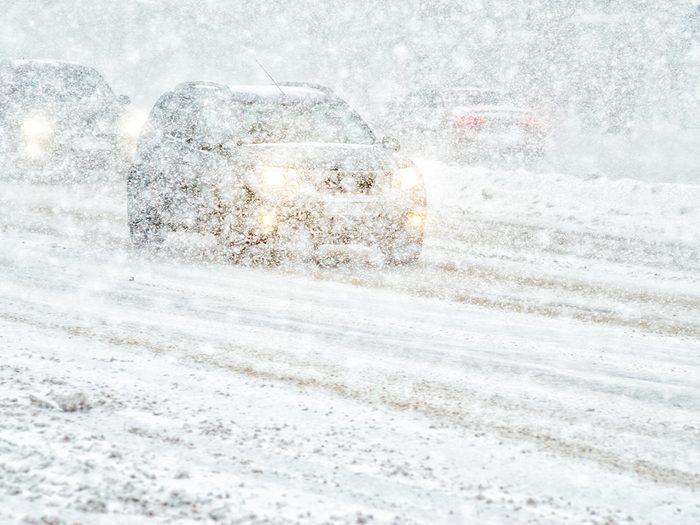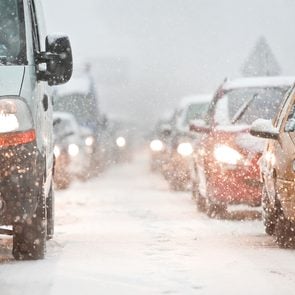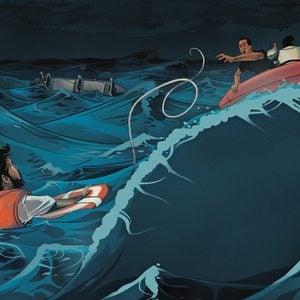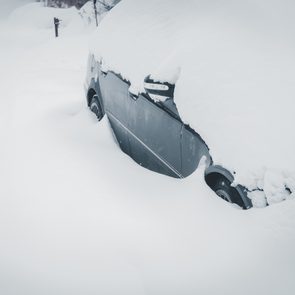A Deadly Snowstorm

On December 13, 2010, hundreds of motorists were trapped by a blinding snowstorm, which shut down a 30-kilometre stretch of highway in southern Ontario. Here's one driver's story of a very long day.
Kathy Glezner was making good time. It was 8 a.m. and the 25-year-old nurse had just finished a string of 12-hour night shifts at a London, Ontario, hospital. She was bone-weary, but glad to be sailing along Highway 402 to Sarnia, where she lived. During the night, Environment Canada had posted a snow squall alert. Nothing unusual—lake effect blizzards are common on this exposed highway, which runs between Lake Huron and Lake Erie. But the calm grey sky convinced Kathy the drive would be safe. “I figured I’d be in bed in an hour,” she says.
Flurries began when she was halfway home. Snow was whipping across her windshield. A snowplow and police car in the ditch were her first clues, she says, that “the road was starting to get bad.” She slowed. Then at the turnoff for Forest, just 20 kilometres from Sarnia, she arrived at a line of stopped cars. She queued up as vehicles rolled in behind and alongside, boxing her in.
Listening to the radio, Kathy learned the highway was closed because a tractor-trailer had slid off the road. Crews were already on the case. She texted some friends and her mom, and tried not to nod off as she waited. A deep sleeper, she was afraid she wouldn’t rouse when traffic started moving.
Kathy received her first text message from Cris Lapointe mid-morning. Married to her cousin, Cris is the family’s go-to guy when someone is in a jam. It wasn’t snowing in Sarnia, so Cris figured the highway wouldn’t be closed for long.
After a couple of hours, however, conditions worsened. Gusting winds began rocking Kathy’s car. She couldn’t see anything outside, and snow was drifting up her doors. It was, she says, “a total whiteout.”
As a nurse who works on a busy cardiac ward, Kathy isn’t easily fazed. She was bored and exhausted, but suspected she was not in any immediate danger. She had a box of crackers for snacking. She had her car cellphone charger. She also had a full tank of gas, making it safe to leave the motor idling for the moment. She kept herself busy texting back and forth with friends and following the news about the storm on the local radio station.
Late in the afternoon an Ontario Provincial Police (OPP) officer came by on a snowmobile. He was checking on stranded motorists and asked if she was in any difficulty. She said she was fine.
She asked the officer if there was any way to get past the truck. “No, ma’am,” he answered. “You’re not going anywhere.”
Once it got dark Cris decided to take action. He texted Kathy to tell her he would drive the back roads in his four-wheel-drive pickup truck to get to the highway and find her. An hour later he had to turn back. “The farther out of Sarnia I got, the bigger the drifts,” he says.
At 6:15 p.m. traffic on the highway started to move. But by 7:30 Kathy had inched only five kilometres before the OPP directed her to an off-ramp. On the radio she’d heard about some emergency shelters, but until this point was still hopeful she’d make it home. “That’s when it hit me,” she says. “I’m here for the night.” Soon after, Cris set out again, this time on a friend’s snowmobile. He brought with him sandwiches and riding gear for Kathy.
As he rode slowly alongside the row of immobilized cars and trucks, people would roll down their windows and ask for help. “I was the first person they’d seen in six hours.” He explained he was picking up his cousin. “I was pretty blunt. I told them, ‘Hunker down. Nobody’s coming and I can’t take you.'”
About 9 p.m. he located Kathy’s vehicle. An OPP officer, glad that at least one traveller under his charge was going home, directed Kathy to pull her car onto the shoulder. While Kathy suited up for the ride, Cris called a snowmobiling buddy in Sarnia. Worried about the size of the drifts, he wanted backup if they got into trouble.
Near 10 p.m. they headed for home. And then the fun started.
About five kilometres into the journey, Cris made a mistake. What he thought was a shallow ditch turned out to be a deep trough. Instead of coming out the other side, they just kept going down. When they hit bottom, he and Kathy were in light, feathery snow that was over their heads. “We had to kind of swim out,” says Kathy. The experience was over so fast she didn’t have time to be scared, but what was starting to worry Kathy and Cris was how cold her feet were getting. Cris was also uneasy about Kathy’s gear—especially her footwear, which he dubbed “dancing boots, not snowmobiling boots.” Kathy began to wonder whether she was suffering from frostbite.
After extricating themselves they spent an hour trying to haul the sled out by digging around it with their hands and pulling. It wouldn’t budge. At 11 p.m. Cris reluctantly called his friend.
Kathy and Cris asked a trucker if they could wait in his cab. Kathy was very glad to be inside; her feet were so cold she couldn’t feel them. As they slowly warmed up they started to hurt.
The trucker was glad to have company. They talked about the storm and compared notes. As thanks for a warm place to wait, Cris gave him the sandwiches he had brought.
Two of Cris’s friends arrived an hour and a half later. The three guys dug out the sled, but now Kathy’s feet were aching. They couldn’t chance getting stuck again, so it was decided Kathy would ride on the back of the friend’s more powerful machine. They got back on the highway.
Kathy doesn’t remember much of the last part of the trip. Her feet were throbbing. She squeezed her eyes shut in fear as they roared along the shoulder of the road, passing all the stranded cars. She was terrified the snowmobile would hit something in the dark. “That was the only time I was really scared,” she says.
Cris took it all in, awestruck by the fury of the storm. Huge new drifts had formed since he’d come through earlier in the night. “I drove up one drift—it must have been seven feet tall and 15 or 20 feet across. It was a solid piece of snow, like a hill, but no hill had been there earlier,” he recalls. “That’s something I’ve never seen before.”
Finally, Kathy’s snowmobile came to a stop outside Cris’s friend’s place. Kathy fell into the snow as soon as she stepped off. Her feet were so cold and sore they wouldn’t hold her. And the pain was moving up her leg. She had to be half-carried inside, where the men helped pull off her boots. She waited excruciating minutes while her bright-red feet began to thaw out. “I was pretty concerned,” she says. But she was lucky—there was no lasting frostbite damage.
It was almost 3 a.m. when Cris dropped Kathy off at her place. Her mom had waited up. They sat at the kitchen table, ate shortbread cookies and had a drink. Before Kathy hit the sack they spoke about how it might be time to consider moving to London to avoid the winter commute.
In all, 600 travellers were stranded for as long as 48 hours. Seven communities set up emergency shelters and many local residents opened their homes to travellers. The state of emergency—first declared at 9:45 p.m. on December 13, 2010—remained in effect until 8:15 a.m. on December 16, when the last of the travellers were rescued by local snowmobile clubs and three Canadian Forces helicopters.
One person died in the storm. On the first night, 41-year-old Neeland Rumble’s vehicle got stuck in a snowdrift. The security guard, who wasn’t carrying a cellphone, walked towards a nearby farmhouse to call his parents and borrow a pair of snow pants so he could continue to his job at a solar farm just 250 metres away. But he didn’t make it.
Rumble’s body was found in a snowdrift the next day. Police believe he became disoriented in the severe weather. He died of hypothermia.
Take a look back at the worst snowstorms in Canadian history.






